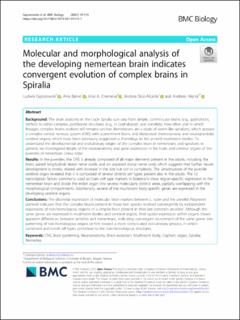| dc.description.abstract | Background
The brain anatomy in the clade Spiralia can vary from simple, commissural brains (e.g., gastrotrichs, rotifers) to rather complex, partitioned structures (e.g., in cephalopods and annelids). How often and in which lineages complex brains evolved still remains unclear. Nemerteans are a clade of worm-like spiralians, which possess a complex central nervous system (CNS) with a prominent brain, and elaborated chemosensory and neuroglandular cerebral organs, which have been previously suggested as homologs to the annelid mushroom bodies. To understand the developmental and evolutionary origins of the complex brain in nemerteans and spiralians in general, we investigated details of the neuroanatomy and gene expression in the brain and cerebral organs of the juveniles of nemertean Lineus ruber.
Results
In the juveniles, the CNS is already composed of all major elements present in the adults, including the brain, paired longitudinal lateral nerve cords, and an unpaired dorsal nerve cord, which suggests that further neural development is mostly related with increase in the size but not in complexity. The ultrastructure of the juvenile cerebral organ revealed that it is composed of several distinct cell types present also in the adults. The 12 transcription factors commonly used as brain cell type markers in bilaterians show region-specific expression in the nemertean brain and divide the entire organ into several molecularly distinct areas, partially overlapping with the morphological compartments. Additionally, several of the mushroom body-specific genes are expressed in the developing cerebral organs.
Conclusions
The dissimilar expression of molecular brain markers between L. ruber and the annelid Platynereis dumerilii indicates that the complex brains present in those two species evolved convergently by independent expansions of non-homologous regions of a simpler brain present in their last common ancestor. Although the same genes are expressed in mushroom bodies and cerebral organs, their spatial expression within organs shows apparent differences between annelids and nemerteans, indicating convergent recruitment of the same genes into patterning of non-homologous organs or hint toward a more complicated evolutionary process, in which conserved and novel cell types contribute to the non-homologous structures. | en_US |

